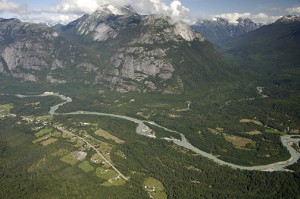Remote British Columbia town experiments with clean energy storage

Located about 250 miles north of the city of Vancouver in British Columbia, the scenic town of Bella Coola -- population about 600 people in the town and close to 2,000 in the valley -- is a great example of the role that microgrid technology will play in the future of the electric grid.

That's because Bella Coola is not connected to the BC Hydro provincial electricity grid. It relies on diesel fuel trucked into its remote location along with a local river to generate its power. The big problem with that clean-generating source is its intermittent nature. In other words, the town has had no way of storing energy generated by the river. Not to mention the fact that is has to fly the diesel fuel into its location, which isn't a sustainable alternative, not to mention unreliable when the weather doesn't cooperate.
Enter a project spearheaded by BC Hydro, GE and clean energy development company Powertech, with some backing from Sustainable Development Technology Canada (SDTC) and some provincial funding. The Hydrogen Assisted Renewable Power (HARP) project centers on an energy storage system that is helping the town optimize the clean power produced by the run-of-river power system. The system is supposed to help offset Bella Coola's annual diesel consumption by about 53,000 gallons (200,000 liters), which will have the effect of reducing greenhouse gas emissions by about 600 tons annually.
The HARP technology works by using the river source to convert electricity used during peak flow periods into hydrogen, which is then stored in a fuel cell for future use. GE's microgrid controller technology plays a role in responding to the changes in supply and demand to make sure that the electricity is managed as efficiently as possible. It uses the river power first when possible then kicks over to the diesel generators.
Juan Macias, general manager of smart substation technology for the GE digital energy business, says the amount of clean energy that the town is able to use varies depending on the time of year. Obviously, when the river runs low, the clean energy supply runs in parallel. Stiill the project could, ultimately, be expanded to integrate other renewable energy sources.
Macias says systems like the one used by Bella Coola could be extended to other remote towns, military installations or even to organizations such as university campuses that may be looking to better integrate their renewable energy resources into a system that they can manage more efficiently. One reason you can't just direct connect things like solar, wind or even river power directly to existing electric grids is because the voltage generated is different than what is usually generated and distributed by utilities, Macias says. "The electric grid distribution system was not designed to have generation sources connected at medium voltage," he explains.
Vicky Sharpe, president and CEO of SDTC describes the Bella Coola effort:
"This project could have a significant impact on the everyday lives of Canadians who live in remote communities. By using clean technologies and a microgrid instead of diesel-powered generators, communities such as Bella Coola will be a lot less dependent on fossil fuels, therefore greatly reducing both their greenhouse gas emissions and their energy costs."
It sure makes the idea of living "off the grid" in Bella Coola seem a lot more attractive. Do they have wireless?
This post was originally published on Smartplanet.com